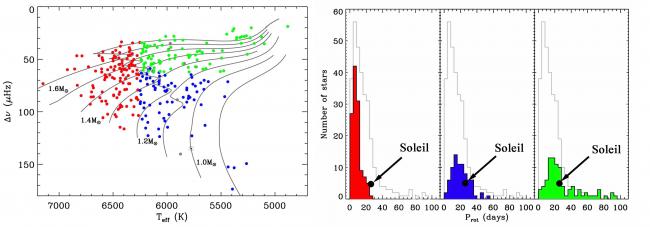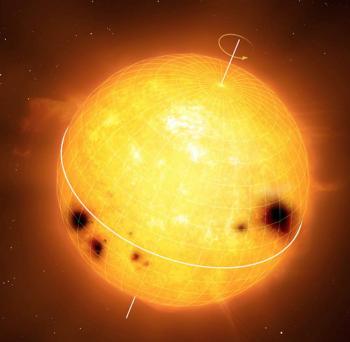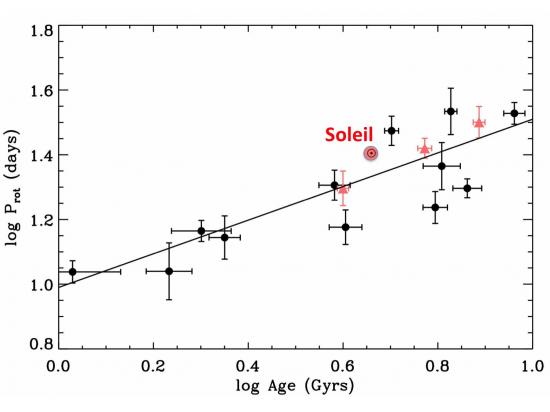An international team of researchers, led by the Astrophysics Department of CEA-IRFU, has accurately measure the rotation period and the level of magnetic activity of 310 stars with masses close to the Sun, the largest ever assembled sample. These measurements were obtained by the study of weak oscillations in the star luminosity detected by the Kepler satellite (NASA). These oscillations are the manifestation of seismic waves propagating in stellar interiors and their frequencies are used to assess the age and rotation speed of the stars. The study confirmed accurately the slowdown of the stars as they evolve. These results, which bring new light on this aspect of stellar evolution, are published in the journal Astronomy & Astrophysics de décembre 2014.
Stars at different stages of their evolution
The researchers were able to study a sample of 540 stars of masses close to that of the Sun at different stages of their evolution. For 310 stars, the rotation speed could be estimated, varying from 1 to 100 days. The Sun, for example, is in the midst of his life with an age of 4.5 miliards of years and its speed is 25.4 days.
In the sample, the stars can be classified into distinct groups according to their surface temperature and to a global seismic parameter directly related to their internal structure. Three different groups are thus observed: the stars with a structure very close to that of the Sun (in terms of mass, radius, and temperature) and at the same stage of their evolution (on the Main sequence corresponding to the fusion of hydrogen in the centre of the star); the stars that are also on the Main sequence but significantly more massive than the Sun (above 1.3 times the mass of the Sun) and the more evolved stars that have left the Main sequence and where the fusion of helium instead of hydrogen is taking place at the centre of the star.
Theory predicts that these three groups of stars should have a very different rotation speeds. The distribution of the measured rotation speeds in the different groups has confirmed this trend. Specifically, the most massive stars in this sample are young and rotate faster than those more close to that of the Sun, that are cooler and older. As to the more evolved stars, they generally rotate more slowly and have a range of rotational periods much wider.

Left: The distribution of the differents stars according to their surface temperature and to an overall seismic parameter, directly related to their internal structure. The lines mark the star of the same mass. Three groups are distinguished by their colors : in blue, stars with masses close to that of the sun; in red, stars of higher mass than the Sun but at the same stage of development and in green older stars, at a more advanced stage in their évolution
Right: The distribution of different ratation periods for the three groups shows that older stars rotate more slowly.
Among the stars near the Sun, fifteen are particularly interesting. The high quality of the seismic observations has allowed to determine their age extremely accurately (to within several %), an accuracy unprecedented for isolated stars i.e. that are not part of star clusters. The distribution of age with the rotation period for these fifteen stars shows that their rotation period varies very regularly with age. The law governing the slowdown had been deducted by the physicist A. Skumanich in 1972 through the study of several star clusters. The present work shows for the first time its validity for more numerous stars all throughout their evolution.
Contact : Rafael GARCIA,
Publication :
"Towards asteroseismically calibrated age-rotation relations"
R. A. García, T. Ceillier, D. Salabert, S. Mathur, J. L. van Saders, M. Pinsonneault, J. Ballot, P. G. Beck, S. Bloemen, T. L. Campante, G. R. Davies, J.-D. do Nascimento Jr., S. Mathis, T. S. Metcalfe,
M. B. Nielsen, J. C. Suárez, W. J. Chaplin, A. Jiménez, and C. Karoff
published in Astronomy & Astrophysics 572, A34 (2014)
see also- Les jumeaux du Soleil (09 juillet 2014)
- Au coeur du Soleil (05 mai 2014)
Redaction : R. Garcia, J.M. Bonnet-Bidaud




